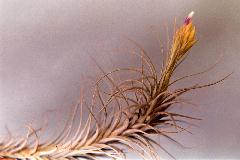
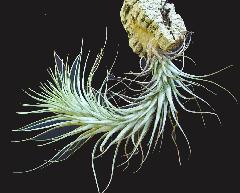
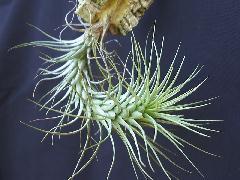
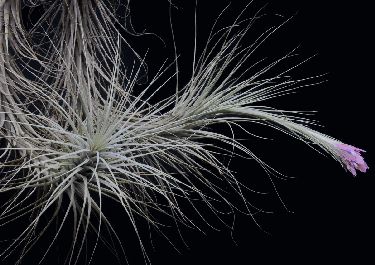
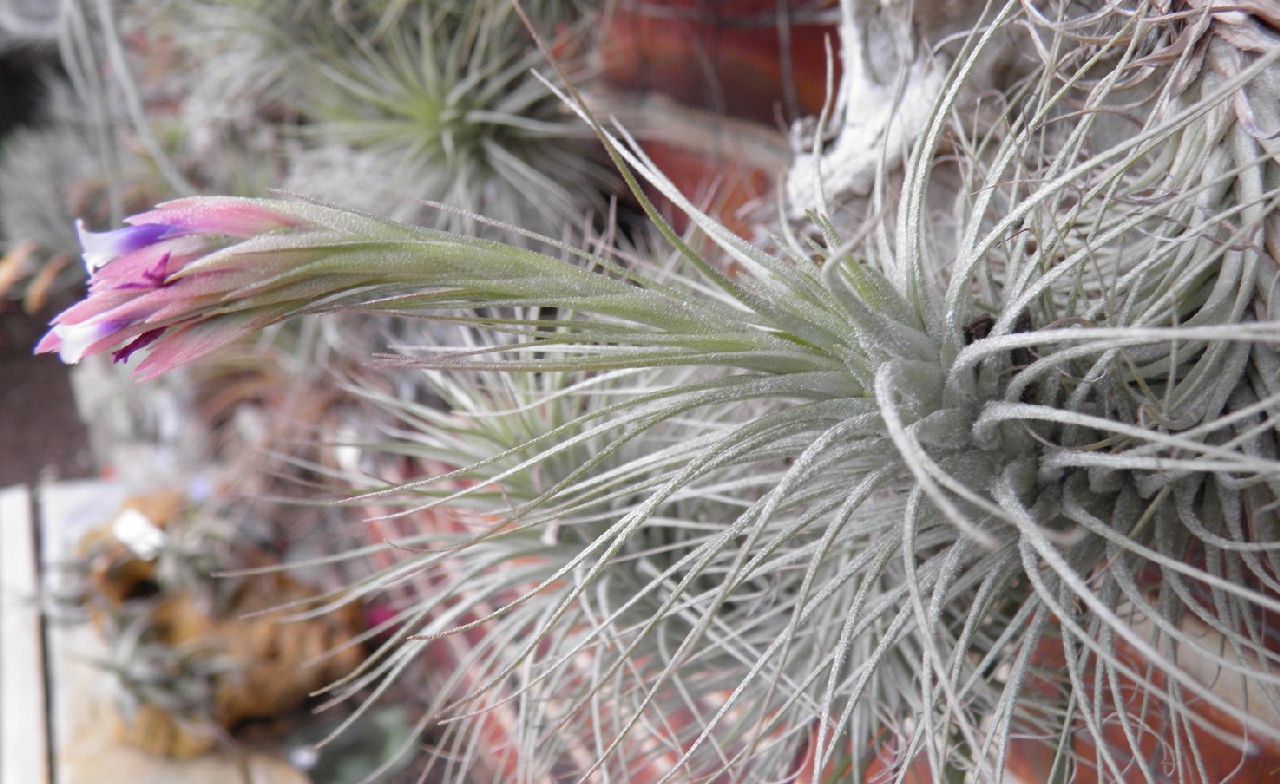

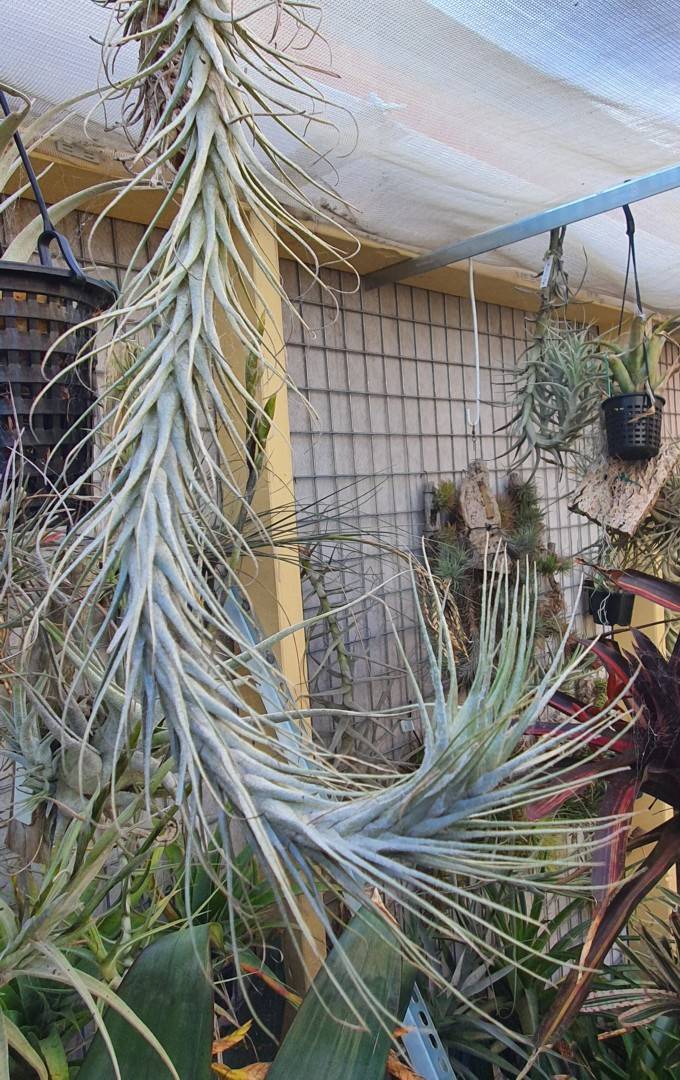

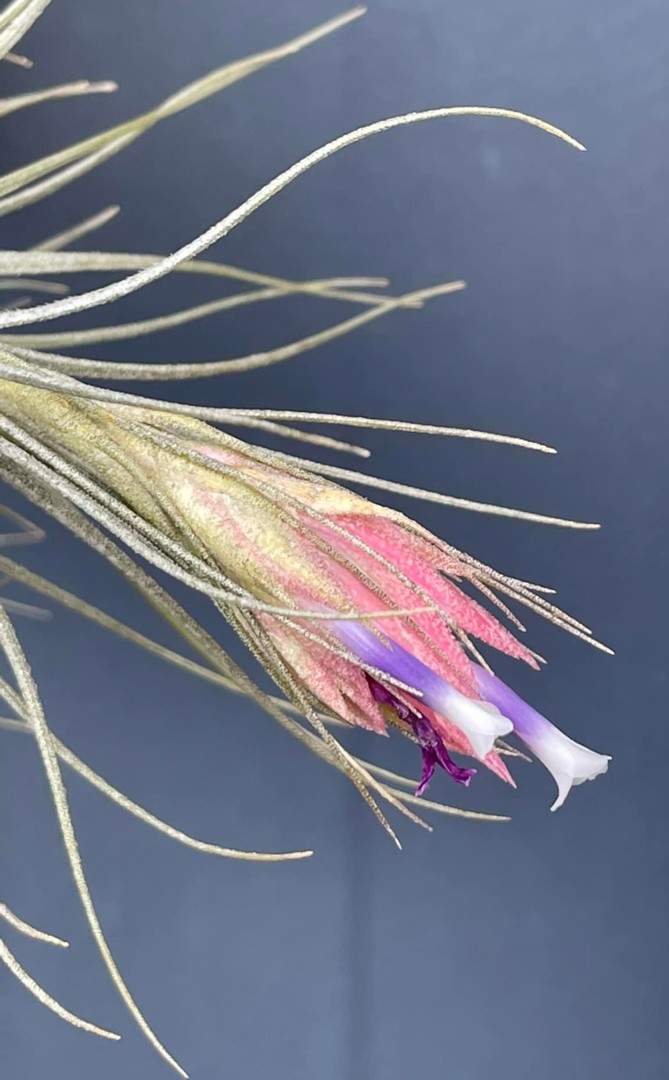
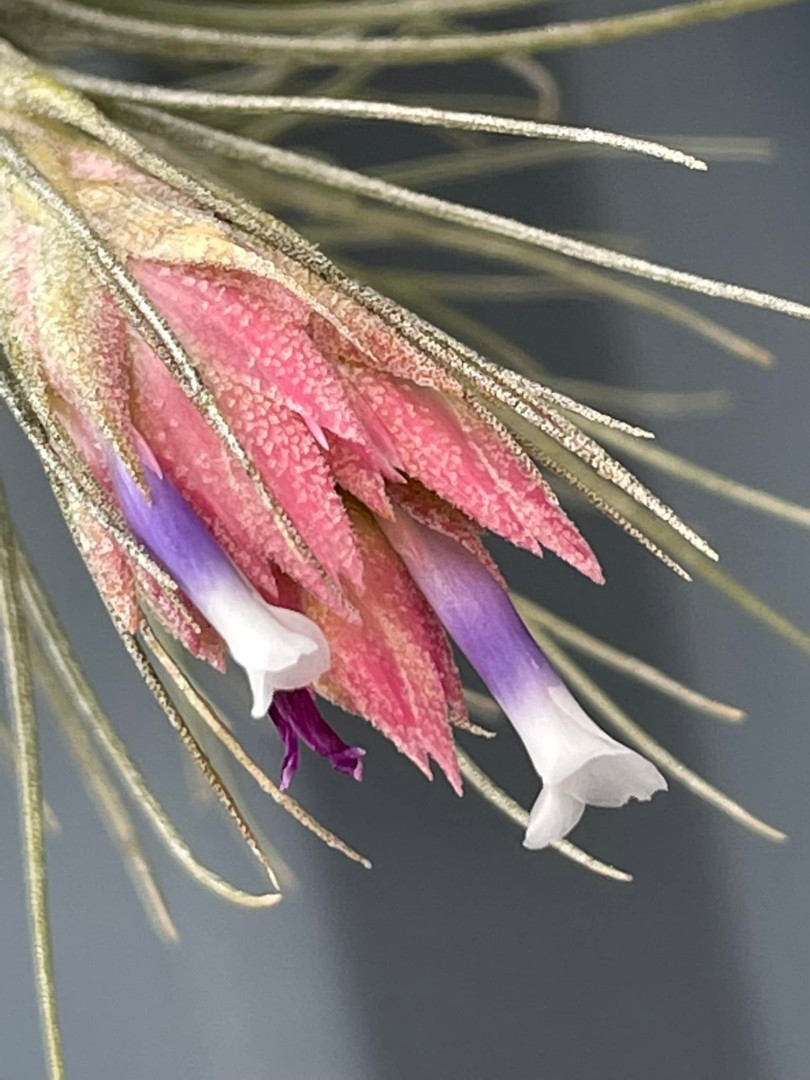
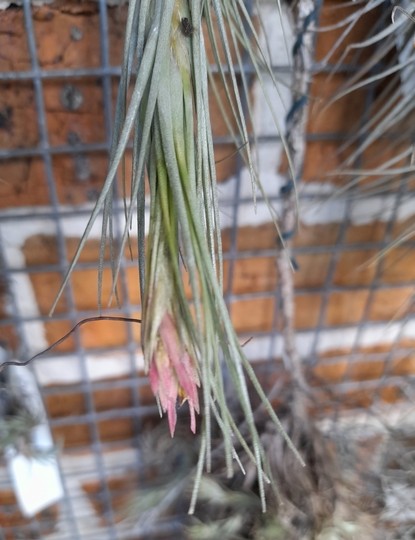
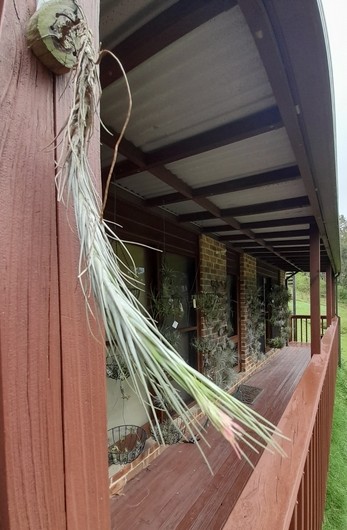
Material studied :
Peru, Ancash: Masin, 2700 m, 04.08.1978, H. & L. Hromadnik HR 4215 (WU); 2600 m, H. & L. Hromadnik HR 4222 (WU); above Masin, 2700 m, 13.03.1997, H. & L. Hromadnik HR 23151 (WU); Rio Puccha, 2350 m, 13.03.1977, H. & L. Hromadnik HR 23154 (WU).
Tillandsia heteromorpha var. rauhii L. Hrom., var. nov.
A varietate typica habitu majore et foliis, inflorescentiis, spicis, bracteis floriferis et sepalis longioribus differt.
Type: Peru, Cajamarca: upper part of the Rio Chancay valley, 1200 m, 22.08.1976, H. & L. Hromadnik HR 2181 (holo USM, iso WU).
Paratypus: Peru, Cajamarca: Rio Chancay, 900 m, 30.07.1978, H. & L. Hromadnik HR 4208 (WU).
Plant forming dense clusters, stems thin, branched, to 40 cm long.
Leaves very densely polystichous, (2-) 6-12 cm long, suberect to spreading, rarely strongly appressed to the stem and forming narrow shoots;
sheaths thin membranaceous, triangular, 15 mm wide at base and glabrous for 5 mm, broadly ovate above and appressed leathery brown lepidote on both sides, except the broad chartaceous margins; merging inconspicously into the blades;
blades 6 mm wide at base, rigid, involute, tapering to a filiform tip, somewhat shiny because of the densely appressed scales;
Scape 2-12 cm long, slender, hidden by the densely imbricate foliaceous scape bracts;
scape bracts: sheaths 7 mm wide, oblong-oval, thin, nerved, pale green, outside lepidote, with an erect filiform blade.
Inflorescence forming an ellipsoid head 2.5-3 cm long, equalling the leaves or slightly longer, with from 3-5 (-7) erect, complanate, 5-flowered spikes;
primary bracts apiculate-lanceolate, 17 mm long, 6 mm wide, nerved, outside densely and inside punctulate lepidote, rose;
spikes 3 cm long, 8 mm wide, sessile, 3-4-flowered, a larger sterile part below with 2 stunted bracts,
rhachis flexuous, densely lepidote, excavated;
floral bracts densely imbricate and covering most of the rhachis, 18 mm long, 7 mm wide, oblong-ovate and apiculate, strongly carinate and one half folded together, nerved, coriaceous, outside sparsely and inside punctulate lepidote, rose.
Flowers sessile, 20 mm long, erect;
sepals 14 mm long, 4 mm wide, acuminate-lanceolate, subcoriacous, even, outside sparsely spreading lepidote, equally subfree, the posterior strongly carinate, rose;
petals 18 mm long, narrowly lingulate, 2.5 mm wide, upper part white, lower 2/3 violet;
stamens 15 mm long, filaments white, straight, anthers 2.5 mm long, basifixed; pistil shorter, 12 mm,
ovary 3 mm high, ovate, green, style white, stigma with short spreading lobes, Typ I according Brown & Gilmartin.
Habitat and range: This variety was found near the coast in a dry valley of the Rio Chancay in the province of Cajamarca in North Peru. This valley is named Sta. Cruz valley in the literature, because it crosses the Andes, from the Pacific towards the settlement Sta. Cruz at the top. The new variety is found at an elevation of only 500-1200 m and grows together with T. lymanii Rauh and the endemic T. latifolia var. leucophylla Rauh.
The plants from the Chancay valley do not grow in small groups on vertical rocks like T. heteromorpha var. heteromorpha, but rather as large distinctive cushions on slightly inclined rock plateaus and on the upper side of large rocks found on the strongly eroded steep walls of the valley on high conglomerate towers. As terrestrials on these slopes, they can grow up to several meters across. Prof. Rauh described a dwarf form growing in the Chancay valley that resembles the highland form. However, the single plants of the new variety are much bigger on average and very different from the highland form with regard to leaf and stem length as well as rosette diameters. Also, the leaves, the inflorescence, the spikes, floral bracts and sepals are longer than with T. heteromorpha var. heteromorpha.
Prof. Rauh points out particularly that "in the original diagnosis nothing was mentioned of the many shapes that the species name suggests". One must also take into account that the plants from the type locality were only known from the specimen Weberbauer 3472, deposited in the botanical museum of Berlin-Dahlem (B). With regard to the population from the Sta. Cruz valley, Rauh (1974: 26) states: '...since the original diagnosis of T. heteromorpha is quite incomplete and little is known about the location details, complementary statements on morphology and ecology shall be made subsequently'. We are reminded of both a similarity and differences with T. tectorum. In T. heteromorpha, the densely arranged trichomes are less eccentric and therefore less spreading. The spikes in T. tectorum are more spreading.
In contrast to the plants of the type population (T. heteromorpha var. heteromorpha), the individuals of the second locality are somewhat similar to T. tectorum in the vegetative stage. Some of the large forms from the Chancay valley actually resemble T. tectorum, because of their leaf length and the relatively large rosettes. Nevertheless, the mostly appressed scales and the shorter inflorescence characterise them without a doubt as specimens of T. heteromorpha.
The plants that grow near the coast differ rather strongly vegetatively from the forms of the highlands, although they do develop an identical inflorescence. It would not be justified, therefore, to treat them as a separate species. The rank of a new variety, however, seems reasonable. This population was named after its discoverer, Prof. Werner Rauh.
The differences between T. heteromorpha var. rauhii and the caulescent T. tectorum var. tectorum are larger than it appears at first glance: The length of the stem widely surpasses the length of the leaves in all forms, but in T. heteromorpha the leaf blades have an almost metallic shine because of the densely appressed scales; the much shorter leaves (1.5-12 cm) are always very dense along the stem, and often (the population at the type locality always) secund, bend upwards. The scape is glabrous; the inflorescence is usually not longer than the leaves and is exceeded at least by the filiform blades of the primary bracts, the compact heads are 20 mm in diameter, only 25 mm long, digitately composed of dense, closely to each other arranged spikes; the primary bracts are almost 2/3 as long as the spikes; the spikes are sessile, only 2.5-3 cm long, 3-(5)-flowered with 2 sterile bracts at the base, very strongly complanate and biconcavely squashed flat in cross-section; the rhachis is strongly flexuous, densely lepidote; the imbricate floral bracts are 18 mm long, i.e. longer than those of T. tectorum, tipped, strongly winglike keeled, the upper half squashed flat in the middle. The flowers are erect, but with a clearly straight tip; the sepals are glabrous or evenly lepidote on the outside, not just scaled on the keels like T. tectorum; the petals are violet, white only at the tips.
Tillandsia heteromorpha Mez, Repert. Nov. Sp. 3: 41. 1906.
Desc from S&D p808
Plant prostrate, caulescent, 2-3 dm long.
Leaves densely imbricate along the stem, polystichous, mostly secund-curving, 55 mm long, covered with appressed gray scales;
Sheaths short and broad, submembranous;
Blades subulate, filiform-attenuate, 7 mm wide, rigid.
Scape very short, exceeded by the leaves;
Scape-bracts imbricate, mostly laminate, submembranous, striate, lepidote.
Inflorescence bipinnate, ellipsoid or globose, 25 mm long, 20 mm in diameter;
Primary bracts elliptic, acute, all somewhat shorter than the spikes, membranous, striate, lepidote;
Spikes sessile, lanceolate, acute, 20 mm long, 8 mm wide, 5-flowered.
Floral bracts imbricate, acute, 12 mm long, carinate, coriaceous, even or nearly so, finely lepidote;
Flowers subsessile.
Sepals equally subfree, acute, 12 mm long, carinate, chartaceous-coriaceous, even, glabrous;
Petals erect, 17 mm long, violet with white apices;
Stamens and pistil included.
Type. Weberbauer 3742 (holotype B, F photo 11503), valley of Rio Puccha above Masin, Hauri, Ancachs, Peru.
DISTRIBUTION. Saxicolous, 850 m alt, northern Peru.
PERU. CAJAMARCA: Santa Cruz: Cumbil to Catache, 20 May 1965, Lopez & Sagastegui 5173 (TRP, US).